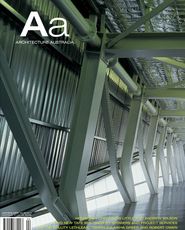THE RECENT RAIA CONFERENCE WAS CAREFULLY STRUCTURED TO GENERATE DEBATE AND DISCUSSION. IN THE SPIRIT OF FOSTERING ONGOING CONVERSATIONS, WE PRESENT EDITED TRANSCRIPTS OF THE ‘COUCH SESSIONS’ THAT FOLLOWED THE FORMAL PRESENTATIONS.
AS CREATIVE DIRECTOR for the 2005 RAIA national conference, my ambition was to provide a space for delegates and speakers to exchange ideas and opinions, to swap experiences about contemporary architectural practice. Accordingly, this year’s conference format was structured to encourage conversation – including the much enjoyed “on the couch” debate – to supplement the more formal presentations by local and international keynote speakers. By placing this informal exchange between peers in the foreground, the audience was able to enjoy the vicarious pleasure of watching the unexpected unfold.We experienced the excitement and associated anticipation of the unpredictable, spontaneous and sometimes wayward tangents and trajectories that the most interesting and compelling conversation inevitably takes. To orchestrate a lively event I had selected panellists not only for the suitability of their particular approach but also for the anticipated fit with other panellists, as if for a good dinner, seeking the right mix of frisson and respect. Having set a question for each session, I had in mind particular directions that I thought the various discussions would take, but am pleased to report that none of them went as planned. Who could have known that the session entitled “logistics” – loosely planned as a conversation around the question of architectural opportunity within constraints of access, material and skill availability (and one I had been told prior to the event sounded a bit dry), which started conventionally and architecturally enough – would within minutes on the couch carry a spellbound audience into the architecturally unfamiliar territory of love and the Book of Revelation? In the spirit of a conference based on exchange between peers, the transcript seems the most appropriate vehicle for documenting what took place. It is important to resist the urge to sum up with an overview, and in doing so provide closure, a defined outcome. Rather the following transcripts leave questions unanswered, thoughts commenced but often unfinished, propositions unsubstantiated or untested. In their incompleteness they invite you to sort through these architectural gems, pick up the loose threads and use them to start further conversations, to extend the exchange that began in Melbourne in April 2005.
KERSTIN THOMPSON, CREATIVE DIRECTOR, RAIA NATIONAL CONFERENCE 2005
Commerce

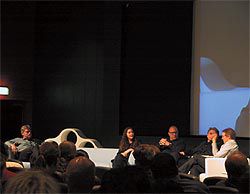
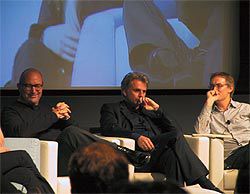
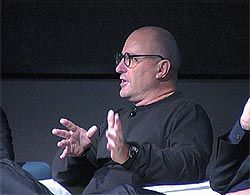
HOW DO ARCHITECTS RESPOND STRATEGICALLY TO THE FINANCIAL IMPERATIVES OF PRIVATE DEVELOPMENT? HOW CAN WE OPERATE WITHIN REALISTIC CONSTRAINTS AND STILL MAKE DISTINCTIVE CONTRIBUTIONS TO THE PUBLIC SPHERE?
KEES KAAN CLAUS EN KAAN, NETHERLANDS IAN MOORE, IAN MOORE ARCHITECTS, AUSTRALIA. FACILITATOR: JOHN WARDLE JOHN WARDLE ARCHITECTS. GUESTS: ZAHAVA ELENBERG ELENBERG FRASER, HAMISH MACDONALD BECTON.
››
ZAHAVA ELENBERG Is there a reason you’re sitting so far away from us?
HAMISH MACDONALD I’m the token developer, I think I’m feeling cornered.
AUDIENCE The range of projects we see from Becton is far and wide, in terms of scale, density and architectural type. Is there a structure or process for selecting architects that links with the aspirations you have for the particular commercial development?
HM Yeah, as with most things it’s probably less sophisticated than people would like it to be. Basically, we work on relationships, our entire business works on relationships. It happens at the front end of a project. For us a project comes from buying a piece of dirt. Typically you don’t have a lot of time to buy and value that piece of land, so you grab someone you know and trust. Someone who can do something quickly to allow you to bid for the site, buy it and maximize its value, probably someone that we’re working on a current project with. Are they the right architect for the project when you move forward? There’s a reasonable argument that they’re not, but we very rarely change architects after we’ve acquired something with someone’s assistance, because it’s just not cricket. So, it’s not terribly sophisticated, it’s relationships. Occasionally we sit down and say, “Right, we’re going to do the Espy and people won’t believe it when we say it’s going to be a really good design, so let’s get a proven architect to add to our brand value.” Hence Fender Katsalidis at the Espy and Ashton Raggatt McDougall in East Melbourne, et cetera.
What I’ve heard today is really refreshing. I thought I was coming down here for a bit of a bashing about why bloody developers won’t pay for more expensive design. It was really exciting to hear architects talk about the value they’ve delivered to very complex processes. My thinking is that architecture is eighty per cent boring, detailed hard work. Twenty per cent is the good stuff and I was really pleased to hear the discussion focus on strategy and communication. Because the great relationships we have are with people who can talk to us, and give us ideas about how things might work, rather than arguing about whether it should be three or four columns on the neo-Georgian facade. It’s the front end where this exchange is most valuable.
JOHN WARDLE Zahava, Hamish has just given you the project, you’ve established the brief and obviously contributed greatly to that. What is the process from there on? There’s not only the drive from the development group, you also counsel in the planning process and many other facets of building. How do you protect the architectural integrity, particularly with the larger scale commercial projects that you have rapidly started to work on in recent years? How can you establish and then protect the endeavour that you put into projects?
ZE That’s always the most difficult thing. Ian hit the nail on the head when he said that he solicits the help of local council and planners.We have very productive relationships with the councils and authorities we work with, and we work together to protect the integrity of the design all the way from master planning to the end product.Working with developers is a very expedient process, and often the project is being marketed and costed and budgeted before it’s been designed. You have a master plan and a set of parameters and everyone is working together to secure the block of land or make the project viable. Before you know it it’s in planning, it’s been sold and you’re left with this thing that was just an idea and that’s what gets built. So, those things need to be planned into it at the front end. You need to enlist the help of people that have the authority to ensure those fundamental principles are maintained throughout the stages of the project.
HM I’ve heard this concept a couple of times this morning and it’s foreign to the way we do business.We have all our arguments up front.We have really robust design arguments before we get a planning permit and before we put a project to the market. I find it really scary that you guys have to enlist the councils to prevent your client shafting your design. One of the points about having a good business is dealing with people that you can trust. I just find this apparent problem astounding, it is not a dynamic we have ever had.
IAN MOORE Kees said something yesterday that is very important in this. That is, a person you start a relationship with on a project of this scale is never the person that you finish the project with. This has been the case in every project where we’ve had significant issues. Our friendly developer, Peter Brown, is always there up front and we do have robust design arguments and we resolve all those, we put it into council, we get it approved. At that point he always leaves and goes to a new organization. Someone else takes over and they slash and burn. It’s at that point – usually at construction – when stuff gets pulled out, always. The help that we’ve got from councils is where they see a significant public benefit in those elements that they’re protecting. That’s why they’re willing and able.We don’t ask them to do this, they have chosen to make these things development consent conditions.
ZE It’s not always the developer who is trying to strip things out of the building, it’s often the project manager or the real estate agents who are looking for a point of difference, or they’ve got new research that says that everyone wants a penthouse apartment.We’re actually doing a project now where the whole building is penthouse apartments. Some happen to be cheap, small, two-bedroom apartments, but the sales pitch is a building of penthouse apartments.
HM We have a different approach.We are vertically integrated, we do our own marketing and construction, so those people are all at the table at the front and we have ridiculously low staff turnover. I call our sales meetings redesign meetings; every week we have our sales people saying “they won’t buy blue”, so blue’s got to go. Hey. But we’d rarely change the core of the project. It’s inefficient, would cost us money, don’t like doing it.
JW Kees, Hamish is deciding to set up Becton Offshore and come to the Netherlands and work within the strictures you work in, where a private developer comes under what seem to us fairly forbidding pressures from local government or state government. I presume the risk is still taken by the developer, but there must be a fairly overbearing presence of the regulatory authorities or government municipality in the development model. How does the forum work for instigating the change that you’ve been seeking in your projects? What advice do we have for Hamish with setting up the protocols that he’d need as a developer who is taking risk in that kind of highly regulated system?
KEES KAAN Yes, there is a highly regulated system in the Netherlands. The planning tradition has brought forth a very strong structure that is also at the municipal level, but it’s gradually dissolving. There are two main things for the governmental institutes in the Netherlands. In some cases they own land, in other cases you have to have their collaboration to be able to change the purpose of the land, what we call the stemming, the destination of the land. So what often happens is that developers, who all own a piece of land, work together and with governmental and municipal institutions to make a private public partnership. They throw in all the land in one bolt, as we call it. Everyone puts his land in the pot and they get a share of the development comparable to the amount of land that they put in. Then a master plan is made. It takes a lot of time. I’m in a process like this at the moment, designing an area with 2,000 dwellings. I was hired by the three developers that own the biggest chunk of land. But they can only proceed if the municipality collaborates, because all the juridical situation around the project has to be adapted to the new development.
So the municipality has their designer and we are there as a designer.We have meetings and they make something and we make something and then we discuss and we try to find a consensus model.We try to work to a plan to which everyone agrees. It’s a very complex situation, because people from both the developer’s side and the municipality keep changing their minds, or they find new reasons to say okay, we don’t need a thousand houses but we need 1,200, and the market is bad for this kind of type, so we have to move or shift. And there is also another programme, of course, there’s a theatre, there’s shopping and there’s always the problem of parking in the Netherlands, because building a parking place is quite expensive and the people don’t want to spend money on buying a parking place. So it’s worked out over two years, something like that, then we have a master plan. It’s politically approved and then architects are selected to participate in projects and it starts all over again. Then it’s divided in pieces and then it’s rediscussed and rediscussed and this goes on until the last building is built and finished. Changes will be there, there will be discussion, there will be architects having discussion with our client, with the developer, trying to get a master planner to help them. Like Ian was saying about trying to get the support of municipal organizations, to get things, to save things for the project, or try to change things. But the developers do the same thing so it’s a game in which everyone is participating and the rules are not written down. But there is a consensus about what you can do and what you cannot do and if you cross a certain line, you’re out and that’s it. The country is very small so you have to be aware that the people that you work with, tomorrow you will be in a meeting room and they change the job and all of a sudden they are no longer working with the contractor, but with your client. You can never afford to be unprofessional or stupid. You always have to be careful.
HM So an architect who couldn’t maintain a relationship shouldn’t go to the Netherlands?
JW And a developer after a quick profit wouldn’t be on the same plane. It sounds forbidding.
KK In our case, it may sound a bit strange, but the problem is more often with the municipality, because of the amount of money they want out of the project. They force the developer to pay a very high price for the land. This price is not connected to the amount of square metres of mud they buy, because it is nothing, most of it is water, the land still has to be made, but it’s a percentage of the price they can sell the apartments for. For instance, if you develop a thousand apartments, the average Dutch person can afford 200,000 Euros for an apartment (something like AU $350 to $400,000). The developer pays 25 to 30 per cent of that price to the municipality for the land. I don’t know whether that’s much or not much … ›› HM It’s too much. (Laughter.)
KK Of course it’s too much, but it puts pressure on the project of course.
JW I might just quickly invite two very quick questions of the audience.
AUDIENCE As you provide a mutual shell, how does your marketing campaign work … in Australia the marketing is often directed to the interior appointments and planning and fit-out of the apartments. You don’t have that as part of the strategy that you employ?
KK The total plan of the area that is developed is often important. For buyers the very important things are the facilities, what kind of neighbours they get, how the streets are … ›› HM They’re all Dutch, I think. KK Of course. But the Dutch are very interested in their environment, so that’s a very important selling point. In terms of the apartments, they are interested in the total square metres, but also the possibilities for using the apartment. So we often have sets of options and different possibilities of dividing the space; you have the same apartment with two bedrooms or three bedrooms and you have a larger living room or you have two or three different positions for the kitchen. There’s a certain flexibility and buyers choose one of those set-ups and the project is then finished together with them. They can choose what kind of kitchen they want and what kind of finishes they want in bathrooms and things like that. And then the final finishes, what’s on the floor and stuff like that, it’s all done by themselves.
AUDIENCE As an architect turned developer I’ve had the occasion to both work for developers and hire and fire architects, and I’m always dismayed to hear the sort of antagonistic, adversarial approach. Can we create a forum where the two sides can get together and realize that we’re all working for a good product at a viable economic base?
IM It’s not always a negative thing. I’ve shown some projects today where we had a negative experience, but there are some very positive experiences. Those last three projects are getting larger and larger and larger with this one client – it’s not the same client organization, but it is the same person moving on and taking us with him. He’s always had faith that we will be able to deliver what he wants from an economic point of view as well as producing some very good architecture. To date we have always delivered. It’s a very good strong relationship and very healthy. In all cases when we start a project and work with the client initially and thrash out all those ideas and get it approved, that’s all fine and the relationship is fine. It’s when people move on and you get new people coming into the team who haven’t got that passion for it because they weren’t in it at the beginning and they’ve been given a role to come in and take six, ten, twelve million dollars out of the project. They have a different agenda from the people who were involved in the first instance, which was all about getting a really good quality product and maximizing everything from a development point of view. It’s that sort of middle management level where we have our most difficult times.
ZE We also have fantastic relationships with developers.We’ve got one developer that we’ve done numerous projects with; I guess it helps that he’s my stepfather. But we have great and very productive relationships with numerous developers. Commercial architects have a very different set of parameters, and I think developers now realize the value that they can add to projects using a design architect. The divisions between a traditional commercial architect and a design architect are being broken down. Not all relationships are antagonistic, a lot are very productive and there is a lot of great work in this city which is testimony to that. There are longstanding and mutually beneficial relationships between architects and developers.
JW Hamish, you started off talking about the importance of relationships in your selection of architects. There are lots of ways to quantify whether it’s successful … but I imagine a lot of it is in the process of participation.
HM Because we’re vertically integrated, when we go to do another project I ask our builder, “Did you have a good run with these guys? I had a good run at the front end putting this project together; did they document it and do the 80 per cent detailed hard bit well?” If the answer there is no, they cost us money, then we may not use them again. But I can’t think of an occasion when we’ve actually sacked an architect or said we won’t use them again.We might have drifted away because we’ve gone somewhere else and their business has gone somewhere else, but we haven’t had a cataclysmic event with anyone that I can think of.
I often describe what we do as the blunt end of social change. Despite the media share that architecture and buildings have lost in modern society, they’re still the longest term legacy that any society can leave behind. The other stuff all disappears. So it’s pretty bloody important. There is a societal expectation that buildings are good for the community, but you’ve got people trying to do it for the least amount of money. I think you’re better off to recognize that that’s not going to go away. So you need to work with people where the relationship is sufficiently robust to get through that, because you’re going to have arguments. You can’t expect people paying for buildings to spend their philanthropic endeavours on that project.We give money to philanthropy, but we make money out of doing buildings. The government has budgets to build buildings, they’re not necessarily going to be a philanthropist on every project. So you’ve just got to deal with the fact that it is,don’t try and get it to go away.
JW Well, to quickly wrap up, many of you may have heard the following quip about six phases of a commercial project. Phase one is enthusiasm, two disillusionment, three panic, four a search for the guilty, five is punishment of the innocent and six praise and honours for the non-participants. (Applause/laughter.) I’d like to thank very much Kees, Ian, Zahava and Hamish for participating today. Thank you very much.
Trade
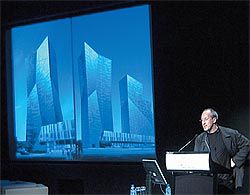
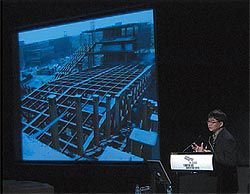

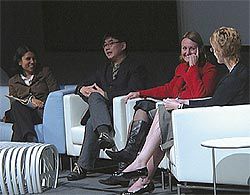


ARCHITECTURE IS NOW INEXTRICABLY PART OF THE IMPORT AND EXPORT ECONOMIES. HOW DO OUR KNOWLEDGES, TRADITIONS, PRACTICES AND BUILDINGS TRAVEL WITHIN THESE GLOBAL CIRCUITS?
››
YUNG HO CHANG ATELIER FEICHANG JIANZHU, CHINA, PETER DAVIDSON LAB ARCHITECTURE, AUSTRALIA. FACILITATOR: FIONA NIXON MINIFIE NIXON. GUESTS: DAVINA JACKSON, ANOMA PIERIS UNIVERSITY OF MELBOURNE.
››
DAVINA JACKSON From some recent surveys I have done it seems that the market for exports of Australian architectural services is now about $80 million, before you consider all the flow-on effects that include, say, Australian engineers that are appointed to project teams, and all the exports of, say, BlueScope Steel products and Caroma bathroom products going into lots of apartment buildings in China. It’s a huge potential market and it’s very, very exciting to see Australia becoming a country that is of note to the rest of the world. I first realized this when a niche opened up with New York and London architectural publishers; suddenly they couldn’t get enough of Australian architecture. Then in 2000 an Italian critic, Sebastiano Bandolino, wrote, “What has become of Italian architecture?” He said there are about eight exciting countries and Australia is one of them, while Italy has lost the plot. It’s very exciting in a parochial way to see Australia go offshore, but it’s also fantastic to see how any decent firm of architects can operate in many different countries. So it’s great that Kerstin has set up this conference where foreign architects are here participating in a conversation that seems to be more equal than past conferences. It’s a landmark.
ANOMA PIERIS I’d like to add to that. I’m sure you all read The Agetoday and saw that large spread with Kerstin’s photograph and the critique of the Melbourne scene. As an outsider it’s really refreshing to be able to pick up a newspaper and read that about a place.
But I would like to reiterate my earlier question to Peter, because I wasn’t satisfied with his response.We need to be wary of subscribing to this engine of late capitalism that is going into China at a terrific speed. My question is, at what point do we take on the role as critics, which is what our profession should do? We are a profession that is concerned for the public, as well as critical of the processes by which we change our environments. Is it enough to do it individually in an aesthetic sense?
I ask this because of an experience in Singapore. I wrote an impassioned critique about this building that was being closed down and going to be redeveloped. At that time I was in Melbourne and my partner was in Singapore, he practises as an architect, and he put in a proposal to redevelop the building and he actually got it! I was just appalled because here I had written this critique of the process and there he was busily changing the building. Of course his argument was Peter’s argument – architects take responsibility about how to change these buildings, that is the way we contribute. For me that’s not enough. It’s just not enough to say by good design, by careful analysis of the situation, by proposing new ideas in these cities we are able to change them for the better. At what point – and I’m hoping somebody will respond – at what point do we begin the task of being critical about the process that we are engaged in? Can somebody respond to that?
AUDIENCE (LOUISE NOBLE) Your question is fascinating. There could be a case for architectural criticism. There are plenty of people out there who would like to comment but sometimes it’s difficult finding a forum. In this digital age we can make use of all sorts of networks to develop the dialogues that are not happening in traditional media.
DJ One thing I’ve observed over twenty years as a journalist is that architects don’t tend to comment seriously in the media because they’re worried about critiquing government systems, they’re worried about losing work, so the debate doesn’t occur in the media. Those who know most about the problems don’t air them in public. There was an interesting thing in Sydney recently. A guy called Ed Blakely, an American developer living in Sydney, is the chair of the review committee for the metropolitan strategy, which seems to be rather fraught. He was on the front page of the Sydney Morning Heralda few weeks ago slamming the NSW Government for its failure to pull together this metropolitan planning strategy. Everyone was thinking, my God, what is this guy doing, he’s going to lose his goodwill from the government. Apparently there was a fight about it, but he’s still talking to the Minister. He told them he’s prepared to leave, yet he says they said no, you need to stay. He stared down the State Government and they didn’t black-list him as has been considered traditional. I’m intrigued by what that case means – can you speak more freely or should you be very careful still?
AP Yung Ho, do you have any experience with the media and reactions to projects?
YUNG HO CHANG Yes, I do. It’s not only the government that architects are sometimes afraid to criticize, but also the developers. There really is the fear of losing jobs. But in China it is also different – there are so many jobs that losing a job or two is not a big deal. So it depends, we do criticize the city or the developer from time to time. I also teach at the university and I have been put on the spot a lot. Usually I wouldn’t volunteer myself, but if asked certain questions I would be very honest. Recently I have criticized the planning of Beijing quite a lot, which is very problematic and very important. Another issue is that architects in China are too busy, they don’t even have time to eat or sleep so they don’t really care if their opinions are voiced. But it’s very important. Even if the city or developers don’t listen to us, we have to let them know what we think as architects. They often think they know about architecture, but in fact they probably don’t know much. I hope more architects will find time and courage to do that.
FIONA NIXON Both you and Peter mentioned that when you are given a project you invariably don’t have a brief and you develop the brief with the client.
YHC Yes, I enjoy having a commission without a brief so that we can actually programme it. Bernard Tschumi talks about programming a lot and I haven’t had a chance to ask him, but I have a feeling he probably hasn’t had much opportunity to do so. But in China there are plenty of opportunities. The frustration comes later. A client might dream a much bigger thing and say, “Don’t worry about the investment, money is not an issue, I want to have the world’s tallest, biggest, strangest whatever”. All the real issues come later and you have to change the programme over and over again.We have done that many, many times.
DJ Do you think a schism is forming between “real building” – the buildings that take real time, three years to design, three years to construct – and the three-week building or city? It seems that different architects are designing them. A lot of your buildings seem to be “real time” buildings that take a long time to design.
YHC In the typical context of Chinese practice the way that our friend Peter works would be considered much more “real”. I’m Chinese, right, Beijing is my hometown, but he’s more Chinese than I am. (Laughter.) Sometimes there is just no way for the client to accept a slower schedule, but a lot of times it’s totally unrealistic to rush. They would waste a lot of time coming back, reshaping their strategy and the brief and so on. So if we can, we ask the client to be realistic about the timetable. And we have been practising now for eleven years and some clients do listen to us, they want to make a profit by having a good product so if it takes a bit longer it’s okay.
AP Is there an imported building syndrome in China? Singapore has it, so I’m wondering.
YHC Yes and no.We have about 110 MacDonald’s in Beijing alone.We have probably 40 Starbucks – they are so expensive but they do very well. It’s the new market economy. People don’t ask if a certain kind of architecture would be more appropriate for China or Beijing or for our culture. They say, is it the best? Is it the fashionable kind of architecture? If it is – and it’s the same with Mercedes and BMW and so on – let’s buy them.
FN It’s branding?
AP Yung Ho, do you have any experience with the media and reactions to projects?
YHC Yes, and it operates on a rather superficial level, so that they don’t mind buying fake. To shop for the fakes is one of the joys of living in China.
FN So you get these Aussie-design fake buildings. A question from Kerstin.
AUDIENCE (KERSTIN THOMPSON) I wanted to pick up on one of Peter’s comments, which we have heard from a number of architects from outside of China including Dominique Perrault – that China is making the mistakes that Europe has already learned from and building twentieth-century cities in the twenty-first century. Is this a specifically Western understanding of current development in China?
YHC Well, you know, I share Perrault’s observation, but unfortunately not many people in China do. It is an outsiders’ observation, but a correct one. The problem with Chinese cities today is not whether they look like Chinese cities or not, but rather that they are becoming unlivable because we have started to rely on private cars. People don’t realize how capitalistic China has become in the past two decades. The whole social system is falling apart – we don’t have the medical care, we don’t have low-income public social housing, we have problems with education, with retirement, unemployment and so on. The cities we’re building are exactly like these social problems; they don’t help people live together comfortably. Beijing has the worst traffic in the world. How to really build a twenty-firstcentury city is an urgent question.
Let’s face it, there are serious architects, there are architects who take on social, cultural responsibilities, and there are architects who don’t. That’s the reality. If you are a serious architect, it doesn’t matter if you are from elsewhere or local, you have to take on these issues, to be very critical, to the point that you may need to refuse to do certain projects.
AUDIENCE (LOUISE NOBLE) Going back to the discussion about media, is there a concerted effort by the government to quell criticism of anything that’s bad in China with regards to urban development?
YHC Whatever media they may control, most people don’t read them or look at them. They have certain newspapers, they give them out free, but, you know, who reads them. And of course you don’t see criticism of the government on TV. But there is plenty in magazines, books and of course the internet. The problem is not that there’s no criticism of some of our Olympic projects or city planning, but that they don’t really listen to any of this.
AP So are there any heated environmental lobbies?
YHC I don’t know how heated, but there are some. In fact there are several very important figures in Beijing. One environmentalist, Liang Chi Chung, is the son of Liang Tse Chung, a very important figure who is the father of our cultural history. The daughter of a very, very important architect in the 50s and 60s is also an activist in terms of protecting courtyard houses. These people are now household names and very popular. Maybe they can’t save this particular house or that particular tree, but at least again their voices are heard. Hopefully they will have a really positive influence down the road.
AUDIENCE If we take it beyond an opposition of heritage and modernism and look at some of the underlying planning principles in modernism, the building is essentially still as icon in the round. You mentioned the phrase “continuous fabric”. There is an absolute lack of engagement with continuous fabric in Australia, we still see property as a driver for building a building on a block of land. It’s interesting that you and Kees are both talking about high density, low rise, interiority, as opposed to an exterior appearance. And Peter’s work was particularly interesting at the end when he was actually talking about a much more complex and continuous fabric in the urban arrangement. Could you talk more on your appreciation of continuous fabric, which is so strong in the traditional cities of China, but not as a heritage or traditional thing, more as an organizing principle?
AUDIENCE (KEES KAAN) I raised my hand with practically the same question, but I will phrase it differently. In the Netherlands we have long experience with large-scale planning. Every ten years fashion in large-scale planning changes.We are now demolishing what was built in the 1960s and the 1970s, to replace it with new ideas, but we keep what is good, so you get a mix and then the real city starts to grow. But urban planning has also become a discipline in itself.We are talking here about architecture all the time, but I think that architecture is not the discipline that addresses the questions that are raised in a country like China. Architecture is irrelevant, in my opinion, to the questions that are at stake – how to house 20 million people every year. To facilitate that of course you need architects to build buildings at the end, but a long planning process has to go in front of that. What I’m feeling is that the wrong instrument is being used, so they are trying to hammer a screw in. Are there urban planners in Australia, are there urban planners in China? The second question is are they at the conference? Is there a serious knowledge about urban planning in China and Australia? I miss this element in the discussion, especially the discussion about larger scale projects.
DJ You’re making a very important point about Australia. I’ve just been at the Planning Institute conference and the diversity of topics there was staggering. Not many architects bothered to attend. In my anecdotal discussions, there’s a feeling among architects that planners are boring – they are the dark side in the architectural consciousness in this country. At the same time there are not many planners at this conference. The Netherlands doesn’t have that divide. So there is a cultural issue to be dealt with here, the divorce between planning and architecture.
YHC Aaron Bestky said once that in the Netherlands land is architecture and I think that’s true. I wrote an article for A+Utwo years ago, a critique of the planning in Beijing. If you see the traffic you would have an impression that there was no planning or the planning doesn’t work, but from our research we found out the opposite. There is a very clear notion of building a city with no density, with very wide roads for cars, not for people to walk, not for pedestrians, and then a collection of object buildings. That was the vision and that’s what you see in Beijing. So, tragically, the planning worked.
Another thing, Peter’s comment earlier wasn’t 100 per cent accurate – we do have 20 million people coming into the city, but all the housing being designed and built every year is for the market. So, in Beijing we have around 80 million people and somewhere between 4 to 6 million of these people are the so-called floating population. Their life has not been planned at all into the city.We don’t know where they live, they can’t afford the market housing. It’s a major problem of cities, these floating people are not considered part of the city. Meanwhile, the high-end apartments are more expensive than anything in Shanghai or Beijing and they are sitting there vacant.
AUDIENCE For any visitor to Chinese cities, one of the most remarkable characteristics is the quality of the air. To what extent are architects involved in environmental debate as opposed to a built form debate?
YHC Sustainability has been talked about a lot in recent years. European standards have been introduced to China and so on, but as to whether they’re actually building buildings which are ecologically sensible … it’s a major challenge. It’s hard to do really, it does raise the budget.
PETER DAVIDSON DID NOT TAKE PART IN THIS CONVERSATION AS HE HAD TO LEAVE TO FLY TO CHINA.
Site

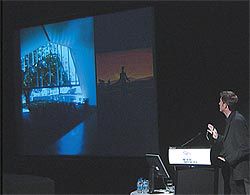


WHAT IS THE SITE OF ARCHITECTURE? HOW DO DIFFERENT CONCEPTIONS OF THE ARCHITECTURAL SITE ENABLE PARTICULAR ARCHITECTURAL RESPONSES TO THE LOCAL/GLOBAL FRAMES WHICH TEND TO DOMINATE CONTEMPORARY SPACE?
››
MOMOYO KAIJIMA ATELIER BOW WOW, JAPAN, GERARD REINMUTH TERROIR, AUSTRALIA. FACILITATOR: SAND HELSEL RMIT. GUESTS: RICHARD WELLER UWA, NIGEL BERTRAM NMBW, RMIT.
››
SAND HELSEL I’m really interested in how you look, and the incredible attention to the detail and specificity of the places you’ve engaged with. But then you zoom out and can see all of Tokyo or Tasmania. So there is a process of zooming out and in and then making very particular marks. Momoyo, what happens when the scale of the built intervention changes? How do you keep that level of care?
MOMOYO KAIJIMA Yes, the scale is very important. In the last building we tried to make a lot of small pieces.We wanted to combine the small pieces with the big scale, and with our intention of the minihouse.We discuss a lot, we learn a lot from the ideas of each client. With the museum, we did it like a house project, the stance is not so different.
SH Richard, that change in scale is intrinsic to landscape architecture, isn’t it?
RICHARD WELLER During the presentations I was trying to get a handle on the general issues in a way that I could then express to the audience to help us see where the presentations sit in the larger scheme of things. So, Sand, if I can put that question of scale aside for a moment? My fairly reductive take on what we’ve seen is that through both sets of projects we can see the consequences, both problematic and fruitful, of the dissolution of the architectural object. In different ways, both are trying to overcome the autonomy of the architectural object, so that they can make connections with the field conditions in which the objects occur. I think this is a philosophical problem that is inherent to architecture. Architecture will always have the problem of subject/object relations, which are so powerfully expressed when a building occurs, particularly in a wilderness setting.
The problem I had with some of the earlier work from Atelier Bow Wow was that if the object dissolves to become a part of its field it announces the end of architecture. It’s an anti-architecture. I appreciate that kind of Duchampian strategy and it’s full of wit and humour, but I found myself starting to worry that if it dissolves so seamlessly into its urban context, where does the meaning of the architectural project lie? I appreciate the economy of means and the simplicity of some of those projects, but I also found them simplistic. However, there is so much in Japan that I don’t understand, that I suspect it’s my problem, not yours.
Gerard is doing something Deleuzian. Deleuze says to make maps, not tracings. In other words, it’s incumbent upon the architect to explore a site and make your own map, not just retrace a site in an instrumental sense. Gerard is also trying to disassociate his architecture from a former generation – the bush hut and all of that – but I think it’s the same project in a different guise. The problem is still that the landscape is appropriated primarily as an aesthetic object. A truly contemporary understanding of landscape is not so visual, it is ecological. It would be more fruitful if we studied the landscape as a complex ecosystem, a datascape. Terroir is still using architecture to represent the landscape or as a machine for seeing the landscape. You know what I mean?
GERARD REINMUTH You’re making total sense. Of course what’s presented today is the first five years in a long journey.We’re trying to understand just what we do. So we start mining backwards to see how other people looked at similar issues, to solidify a position before rushing forward. In this morning’s talks everything was getting bigger and faster and it’s quite exhausting.We’re going quite slowly.We are now finally starting to pump up the volume a bit, or will start doing that in future projects hopefully.
NIGEL BERTRAM The idea of ecology is interesting. Both presenters use that word – Momoyo used urban ecosystems and Gerard talked about ecology. Both started from the relationships between things, as opposed to beginning with a total system and worrying about whether it’s the landscape or the architecture. One of the most interesting slides Gerard showed was the ribbon through the trees. It was a beautiful image of, as you said, trying to overcome the sentimentality of the landscape by studying it with some precision. Atelier Bow Wow’s work is also trying to overcome the enormous over-theorized thing that is Tokyo by looking at very small, intricate and accurate relationships between things. I think this understanding of ecology, and I don’t use the word remotely correctly, is interesting.
GR This idea of making connections within a system is the key aspect for us. I could imagine doing work in Tokyo through the same lens. Of course the results would become quite radicalized because of such a different context, as I’m sure perhaps you’re finding, Momoyo, when you get away from the city.
MK Yeah, we always saw the city as landscape. Now we are interested in the behaviour of the people who also look at landscape – the manner of the people, how they gather in some public space, and how they make some communication in this place. That is also a very interesting observation point for us.
GR The project you showed in China, where you made public space by moving pieces of furniture together, worked on the most fundamental level of what a public space is rather than trying to solve this big problem of public space in Beijing or wherever it was.
RW Yeah, I love that little project too. But there is also the risk of capitulation, of throwing your hands up and saying the city is too hard now, the labyrinth is so complex we can only do these tiny little things. There’s a reluctance to use the power of the architectural project. As much as I appreciate the work, I’m just drawing attention to the fact that through a sort of critique of power you can end up with none! It’s time for re-engagement with big issues, not little arty interventions.
SH But it opens up the range of interventions that are possible now. This is not restricted to buildings, they can be very small moves, they can be twiddling a transportation system. That’s why this work is really interesting. It’s not looking for solutions, it’s trying to find better ways to pose questions, so it offers a much broader range of possible solutions.
NB Earlier, Sand mentioned the idea of diagram. A question for both speakers might be, how does the use of the diagram, which would seem to be a generalizing device, relate to the specificity of observational techniques or ways of looking?
MK For us every space is very experimental. When we start a project we walk around for almost a week in the street, then we feel something, capture some atmosphere and some point of the observation. Then we make a drawing that is more abstract and more perfect.
NB Like those little drawings in Made in Tokyo, which are like diagrams.
MK Yeah.We have to discover how to make a diagram for each issue in each environment. When we make a bigger project, we are not so interested in huge things, or dramatic things. The starting point is very personal, but is also about how to activate thinking in terms of programme or the public. The older generation of Japanese architects say young people like us are always looking backwards. But I think that is a new way of thinking, thinking about the communication in the city. I think it’s more useful for the future.
RW Is there a greater confidence in your generation of Japanese architects in terms of being Japanese and the kind of representational load you expect a building to carry? You seem to drain your projects of representation in many ways and through that, there’s a real confidence in the projects, in terms of identity. Could you speak to the issue of identity and representation in your work? What I deduced, and I could be completely wrong, was that you seemed to be confident about being Japanese.
MK Not so much.
RW No, no-one is confident about being anything, but there seemed to be less anxiety than in some of the earlier Japanese work.
MK I don’t know. I studied in Switzerland for a year. In Switzerland, there is a lot of discussion about the relationship between housing and the city or building in the city. Japanese architects’ discussion is more formal, about the space without the city. Our generation has started to discuss the relationship between the city and buildings. That’s why we have to discuss Tokyo and why we have to talk about the behaviour … but I don’t want to focus only on the Japanese way.
AUDIENCE You could also see site as sight – when you go to a site, you view. I think the difference between these two architectural firms is that they have different ways of viewing, and they have translated those ways of viewing. Gerard talked about the eighteenth-century theories of the sublime and he also showed the paintings of women viewing art through a window, which was constructed in a way. In Tasmania he has this undulating view, this undulating landscape, that he replicates and accentuates through form. A lot of his focus is about looking and viewing art and trying to enhance and intensify that way of viewing. Whereas the work Momoyo has presented is about the limitations of a confined space such as Tokyo, and ways around those limitations. So in the Gei House it’s about using devices in order to view out when there are a lot of limitations being thrust upon the project. They did it quite incredibly and dynamically. These things tie these two architects together – the way that they view and the limitations or the difference in the way that they view. (Applause.)
AUDIENCE I’d like to extend that discussion. Both Gerard and Momoyo were investigating the conditions of the site and trying to understand what the site is and to meld that with the programme which they were required to produce. The connection that I see is that it isn’t important what the work looked like. This brings their work together and differentiates them from architects who are trying to create form and style.
GR I think it’s a very good summary.We’re just very curious, we’re addicted to the process, so there isn’t a sense that it matters how it’s going to come out.
AUDIENCE Momoyo’s work is really beautiful. I just love that all your buildings had names, you know, Pet Architecture and Mushroom House. Roland Barthes in his Empire of Signstalks about how in Japan buildings look like things. Can you comment on language, the power of the metaphor that emerges in your work and this sort of accidental anthropomorphism?
MK Yeah, now we’ve developed a language and we make some structure of the language. I didn’t show you but my partner and I are also researching spatial composition in modern Japanese architecture, and the diagram or language system is very strong within this academic research also.We always investigate the language of the space and how to connect the scenes.
GR The link between the words and the diagram for me is very strong.We have three people in three different locations and so there is a need to draw diagrams so someone 2,000 kilometres away can understand what you’re trying to get at. If you don’t have a diagram and a very clear language about what you’re trying to do, that wouldn’t be possible.
NB But the act of naming things almost makes them exist, like Made in Tokyo, because without naming them they just merge into the rest of the city.
AUDIENCE The Japanese seem to be very comfortable with themselves in their landscape and I think as white Australians we’re not. How can we come to terms with us in the landscape? We are part of the landscape now – how do we start to recognize ourselves in our landscape without completely destroying it?
RW It’s a very big question, but it’s a very good question. I tried to say before that I think there are limits to what architecture can do. It is always going to suffer the same way a human being suffers from being autonomous to a degree but also radically connected to any place that you find yourself in. The only time you truly become part of site is when you die and you become horizontal.
AUDIENCE But we’re not the only creatures who create shelter for ourselves …
RW That’s right. But isn’t it quaint that architecture, after some 10,000 years of settlement – all that time of resisting site – architecture now turns to the landscape, and that it does so precisely at the time that the landscape is virtually completely erased as such. What we are turning to now then is not landscape as, say, in a picture by Casper David Freidrich, we’re turning to a very complex system that we have completely denatured. Only in Tasmania can you look out the window and see a pure other, and even there, as Gerard rightly said, it’s a managed garden. There is so much technology brought to bear to maintain that picture of so-called wilderness. It’s equivalent to the stealth bomber, and I like that metaphor very much, because it’s no longer – well, of course, the landscape is scary if you’re lost in it – but what is truly scary now is ourselves. The meaning of your question was, how can we overcome this duality between object and milieu? Well, we can’t.We can only deal with the anxieties involved in it because that’s part of the human condition – that’s what culture is, that’s what settlement is. Paradoxically the problem of a dual condition between us and the environment does now break down – not because of a philosophical or spiritual breakthrough but because when we look now at the world we see only our own cracked reflection. By covering the globe with our systems so thoroughly we have, in a sense, erased the other. So if nature no longer exists you deal with one homogenous condition which is denatured. This is rich in pathos because we sense a profound loss of otherness but also an exciting evolutionary transition because everything has to be designed. I thought that was expressed by the last project from Atelier Bow Wow where the landscape and architecture had folded into a hybrid of some kind, which is clearly an issue that many architects are currently trying to work through.
GR It’s a very good point. The denial of that problem, the idea that you can romantically live in harmony in some sort of cubbyhouse somewhere, is a concern in our office. In the end we understand that the Tasmanian wilderness is managed, someone draws a line on a map and says this point affects you and this point doesn’t. So what we’re trying to do is continue to manage it, and trying to manage it intelligently or at least with some sort of empathy.
RW Sure, when Australian architects make a building as a homage to the landscape around it, it signifies a cultural evolution to the point where our relationship to the place, our sense of being comfortable in this very alien landscape and very difficult ecology, has changed.We are feeling at home after a couple of centuries, starting to make sense of it as home and take responsibility for it rather than just impose other structures on it, as has been so much the case with our colonial history.
I originally started to critique the idea of building as viewing machine as it seems to me a somewhat passé understanding of landscape, even though buildings, like people, will always need windows. As I read it, Gerard goes onto sites and he maps them and intuits a certain path, which in turn becomes the lie of the land for the building, and then the building unfolds as an expression or representation of the site and the views to and from it. To get towards a truer representation of building now, however, we would, for example, need a map that showed us the sources and movements of all the materials and processes that go into making a building, a sort of four-dimensional and vast geographic datascape.
SH I think this conversation will go on and there’s no need to close it.
Logistics
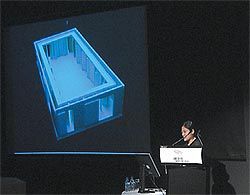
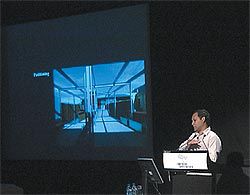
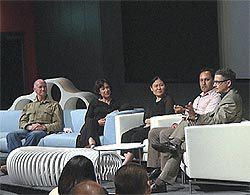
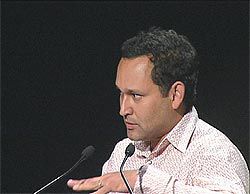
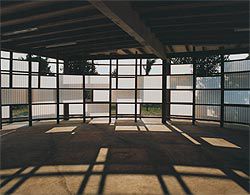

OUR BUILDINGS ARE ALWAYS PARTICULAR TO PLACES, ACCESS, MATERIALS, SKILLS AND TECHNOLOGIES. HOW DO THESE LIMITS PROVIDE US WITH ARCHITECTURAL OPPORTUNITIES?
››
JAE CHA LIGHT, USA KEVIN O’BRIEN MERRIMA DESIGN, AUSTRALIA. FACILITATOR: TIMOTHY HILL DONOVAN HILL. GUESTS: DES SMITH DEAKIN UNIVERSITY, SANDRA KAJI-O’GRADY UNIVERSITY OF MELBOURNE.
››
TIM HILL Well, we have had Jae’s talk about the spiritual and how that immediately involves people and how they make a place, as well as what a building might be. Then we had Kevin’s talk where that issue, coming from quite another spiritual base, ends up in our own country. Both speakers put to us, from their different points of view, that God is in the landscape. Perhaps the challenge is to keep up that piece of imagining, which in most of our practising lives we’re not privileged to do ad infinitum. As people who have made places where collective activities occur, how should we make our little occasion here … do you have questions for each other?
KEVIN O’BRIEN Here’s a story. I have an image of Jae’s church, an internal image of the screens and the light, not because I realized it was a church, but because that quality of light and the sensibility affected my spirit. I had no idea who Jae was, or who the author was and it was pure coincidence that this meeting has occurred.
JAE CHA I wanted to cry when I heard that story. It really touched me.
TH It’s a curious way to meet a speaker; you end up having conversations you wouldn’t otherwise have. I often run into Kevin in Brisbane, but I’ve never heard those things about his background and modus operandi before.
KO That’s because you’re my landlord. (Laughter.)
TH He’s so old-fashioned, isn’t he? Our guests, you’ve been brewing questions for our speakers who have met in this strange way.
SANDRA KAJI-O’GRADY Yeah, I want to begin anecdotally as well. My parents were born-again Christians so I grew up in a church.We would often have Aboriginal people from the Church of Christ Missions the Kimberley brought down to sing and stuff and we’d all feel very congratulatory about our relationship with Aboriginal people. So I immediately have a response to Christianity, which is part of my history. I was thinking about how difficult it is as a critic to deal with spirituality in our current period when spiritualities are so contested.We don’t have the critical language to talk about things such as emotion or personal history. I was thinking about my own discomfort with confronting spirituality in architecture.
JC I totally agree. It’s very hard for me to talk about my projects to the public because they’re so personal. I always get asked, why are you doing that? There’s a very specific personal reason why I do those things and it’s not something that I want to tell everybody.
DES SMITH There must be something evangelical about it, though. They’re public buildings, they can’t be simply personal. You also mentioned a biblical theme park. For those who don’t believe in the particular religion then all religious buildings are to a greater or lesser degree Theme Park. For me, the tough bit is to define when it flips from being a theme park into a project that conveys the kind of difficult spirituality that we say we don’t have the language for. Theologians are actually incredibly good at talking about it. There is a whole language for dealing with it, but most architects don’t attempt to find out how to put those feelings into words, so there’s a leap of faith, which is a topical way to put it. I find that the leap of faith we normally talk about as architects is in fact a schism. I’m curious about where the circular form of the church came from. Can you be more explicit about this, because I don’t think Modernism is in Exodus, but I could be wrong. (Laughter.)
TH Perhaps Michael Parkinson can assist by delaying the cosmic part to the climax of our chat and ask Des’s question in another way. Des says there’s a difficulty in talking about these things as an architect. But let’s ask it in another way, irrespective of your shyness – which is a beautiful and rare thing. You’re making a very personal thing of making buildings for other people. In our country the zone for personal expression is usually the private house, but you and Kevin are directly making buildings for others and, as Kevin points out, we don’t need language to recognize their resonance.
JC About two years ago I was at a conference in the States and I was much more open, I said a whole lot of very personal biographical things and I was criticized by a critic who said, “There’s no place for those personal stories or biographies in architectural discussion.” I don’t quite understand why not, because in a sense aren’t we all artists?
TH Perhaps you could recount to us, anecdotally, some of the resonances that people have ›› with the space. Because people occupy those buildings. The risk you have to take as the ›› author is really not to reveal something about yourself but to say, look, I think there’s ›› something about this thought that the collective is going to recognize. Does that happen?
JC Yeah, well, I mean, with that first project, I was coming out of a period where I felt very ›› restrained – culturally and in every way, religion, Asian culture and all of that. I just wanted to ›› be free, and that project was about completely having freedom, having that freedom in Christ.
TH But I’m going to be a tough nut. Rather than talking about your experience, what can ›› you recount to us about other people’s experience of this building? Did other people recognize ›› the things that you imagined they would?
DS But if I cut to the chase, Tim. Aren’t you supposed to see Christ? It’s a church?
JC Yes.
DS You don’t have to go on about corridors and doors.
JC Well, it’s not that they see Christ. My goal is when you enter it you sense the Holy Spirit, that it is completely free, it’s moving, just like the air, the wind and the light. When people are in that space I want them to feel the Holy Spirit, not just the spirit, the Holy Spirit.
DS So it’s the same spirituality that Kevin is talking about?
KO What I’m talking about has nothing to do with this. The projects I’ve shown – jails, a dance studio, medical research labs – are places of exclusion. What I’m saying about spirituality isn’t delivered through religion. When you guys go on holiday, your spiritual recharging happens on the beach, that’s it, because you’re in constant contact. That’s what I’m trying to find. I’m trying to reveal Aboriginality as something that can be celebrated as a moment when you instil a pride in your identity. All the buildings we’ve done are very functional, building types that are usually considered boring. When was the last time you saw a jail win an institute award, or a medical centre? We can’t get a cultural centre, for instance, which is meant to be the pinnacle of expressing Aboriginality. But who does it express it to? It’s a tourist venture, a theme park for overseas people to see Aboriginal people, really black ones, you know … (Laughter.)
TH You’re saying if only we had a real black one here?
KO Well, this is it.
SKO Can I come back to Jae’s point about people feeling the spirit moving? It comes close to a Modernist idea about art as a transcendent experience. So, I could go to your church and have an experience that felt spiritual or transcendent without being a believer. That’s the kind of Modernist aspiration about the role of artistic beauty. It possibly operates in your work as well, when you’re making design decisions about buildings looking better. For all of us when we are designing, there is perhaps still at work this guilty word, beauty – this aspiration for beauty as a transcendent experience regardless of its religious origins.
SKO The church has been published in a lot of architectural journals. How did that happen? JC Well, I had a project on my drafting board for a couple of years, a photo of an orphanage in Nepal from The Architectural Review. It was just the roof, with two Nepalese guys standing on it, trying to build it. I was shocked to see that in an architecture magazine, because you’re always used to seeing very polished buildings. It was such a moving photograph. That was my inspiration for the Bolivian church. I had no prospect of other commissions, so when it came up I thought, well, I’ll try to make the most out of it, just like that orphanage.
SKO Did you get a professional photographer in or did you photograph the church yourself?
JC The aid worker there had a friend who took that photograph. I don’t think he was professional but he had a decent camera so he did a nice job.
TH Do you think the project had this momentum because you hit on something in the collective interest because it was round? Do you think it made its way into The Architectural Review, and ended up on Kevin’s desk, because it is an emblem that is so well understood?
KO Well, I didn’t realize it was round, it was just that there was something really raw about that one image, the internal one, which I didn’t think usually turned up in that sort of journals.
DS Kevin, why did you say the Opera House is the most Aboriginal building in Australia?
KO I gave a lecture at QUT the other week and I was told our work didn’t look Aboriginal. It boiled down to the lecturer saying there should be more curves. For me the most memorable thing about Sydney that isn’t landscape is the Opera House. It celebrates the moment of being on the harbour, and it takes a foreigner to do it sometimes.
DS There’s a kind of resonance between the building and place?
KO That’s what I’m getting at. What I’m talking about as Aboriginality is something that is vested in the Australian psyche but not necessarily acknowledged.
DS And are you saying that it doesn’t need a particular symbol? It’s interesting that Jae is building churches that aren’t symbols of churches, which means that they’re extremely openended; we’ve just heard of people who didn’t know it was a church, and yet they are moved.
TH Yes. The thing about the Opera House is you don’t have to get its idea to enjoy it, you can interpret it in any way you want. With Jae’s church you can enjoy it any way you want. With a theme park you have to get their idea exactly, so the presence of the author is not so generous. But shall we have some questions from people who are also among us?
AUDIENCE (LOUISE NOBLE) Could you talk about buildings and love? As architects we don’t talk about this, we talk about the things we do, but in fact a lot of what we do is love.
JC For me that’s an easy question. I am doing what I’m doing because I love God, I believe that he’s real and I sense the Holy Spirit. That’s what motivates me to do architecture and to live and so my architecture is completely about love.
SKO If I look at discourse we talk about “the ugly”, we talk about hate, at the moment we talk about opposites a great deal, but we don’t talk about beauty.We are embarrassed about the positive things. It’s not a personal thing, it’s not about my problem with love, it’s about us culturally having difficulties with love and beauty and …
DS Well, it’s a slippery word. Do you mean the love for the person next to you or do you mean the love of a group? At least in Christianity there are three, aren’t there, there’s agape, there’s love of your brother and there’s love of your family or the person that you actually love, so you need some definition. For me as an architect, I think it’s agape, but it’s the love of the community.We all do public work. You do it for someone else, so to be over-attached to your privileged position as an architect and to paint your personal story onto it and think that’s going to get it mileage is a difficulty.
You have to acknowledge yourself and then go, I’m an architect. I can see the world architecturally. I’m quite happy with the love bit, because I think architecture is incredibly positive and love is the most advancing of the positives, certainly more advancing than just liking something. That dedication is crucial. When work is really on a roll, the sheer grunt of the architects gets embedded in the stone. When I go to a Gothic cathedral, I don’t believe the story, with all due respect, but those buildings are spiritual, it’s seeping straight out of the limestone at you.
AUDIENCE Jae’s work has been discussed in a very general manner, but there’s a specific sensibility and a level of sophistication that hasn’t been discussed – for example, the way the cladding wraps around the building. It’s an incredibly sophisticated concept to understand the circle or the box as elements that can engage a site while seeming to be indifferent to that site. What is the genesis of that? Is it your education? Is it something you take for granted?
JC I’m preoccupied with ideas of floating and lightness. My family moved around all my life so I never had a sense of stability, so I’m really fascinated with those ideas and, like I said, the idea of being completely free in all of that.
AUDIENCE But I imagine there’s also a strong education that we haven’t heard about.
TH It’s a question about the cladding interaction, the way the drum is structured, the jointing, the fact that it’s been able to be done in a crude way, how did you learn to do that?
JC It was the easiest thing to do when we were down there. It’s really not complicated … you guys don’t have to dissect it, like …
TH Some of us would like to know how to do it.
JC It’s a circle, because it had to be something I could drop onto any site.
AUDIENCE That itself is a sophisticated concept, where does that sophistication come ›› from? There’s a strong ephemeral sensibility that’s not being discussed.
AUDIENCE I am interested in the generic quality of the projects – generic not only in terms of form, but also in terms of use. You explained it could also be a medical centre or a community space, etc. The discussion went in the direction of the spiritual, but I can imagine that for the people that you made the buildings for, the pavilions could have a totally different meaning. They go there to sit out of the sun, not to pray. Or maybe they play cards or celebrate birthdays. Do you know anything about that? Has the generic quality in the design resulted in other uses?
JC There’s an architectural school in Santa Cruz and the students have architectural discussions in the church every week. I’m totally interested in the idea of generic. I’m not interested in making a sacred space, in terms of space that is only for worshipping God. I want to make every church I do much more multi-purpose.
AUDIENCE Kevin, you didn’t explain your projects in detail, so we only know the thoughts behind them. Do these thoughts lead to generic solutions, or could they also lead to very specific answers?
KO Well, it was a specific move, not to show buildings and talk about process. This was an opportunity to give you a narrative. Oral tradition is very big where I come from. The second thing, well, the stuff I’m talking about is incredibly specific. It’s very specific to place and people and that’s because of it being with Indigenous Aboriginal people. I worked in Ireland for three years and to me it was still the same process. There was an Irish way, an Irish culture, an Irish landscape, stories and a similar way of being very specific. Maybe the process is generic, but I think the outcomes are very particular to place and people. And I can’t draw a curve.
SKO You can’t even recognize a curve.
KO They were squares, they were squares of light.
AUDIENCE I heard that most architects start drawing curves after they turn fifty, maybe …
TH That’s the good ones. The others just become water colourists. (Laughter.) Could we thank our guests. (Applause.)
Occupation
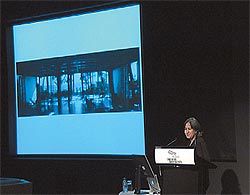
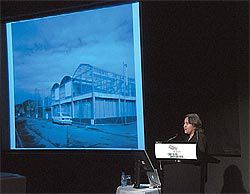
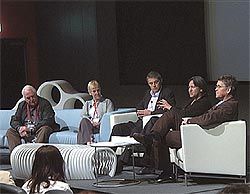
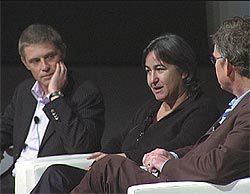


HOW DO WE LIVE? IF ARCHITECTS ARE NO LONGER THE SAVIOURS OF CONTEMPORARY HOUSING, IS IT STILL POSSIBLE FOR US TO OFFER SOME LEADERSHIP IN HOUSING DESIGN?
››
ANNE LACATON LACATON VASSAL, FRANCE, ROB MCBRIDE MCBRIDE CHARLES RYAN, AUSTRALIA. FACILITATOR: SHANE MURRAY RMIT. GUESTS: GRAEME GUNN GRAEME GUNN ARCHITECTS, MARY FEATHERSTON. ›› ››
SHANE MURRAY Well, these talks generated an enormous number of questions and the theme is truly formidable. Perhaps the very first question is to question our premise – this issue of architecture affecting the general condition of housing. Anne has demonstrated architecture’s potential to have a positive effect in the contained field of public housing. Her talk showed the power of research, but also the fact that external economic factors provided a quite irrational obstruction to a very clear process and a positive way of moving forward.
Robert is a bit more sanguine and he’s fairly explicit about the effect he thinks we can have on the suburbs. On the other hand, his work powerfully demonstrates what we can do with enlightened development. I often think that rather than talking about what architecture can do, maybe we need to think about what new combinations of architects and other players can do and where that may take place. Maybe it’s not a role for government or legislation; it’s another type of structure. So I’d like to start with that – where should the influence be and how might we make it happen? Anne, is there a way around the economic problem to make your experimentation on the high-rise buildings applicable?
ANNE LACATON Really there are two issues. First, there is the issue of density - there is a desire to replace tall buildings because they have a bad image, but in France we know it’s a disaster to increase the dimensions of the cities, so density is a necessity. Then there is the issue of economics, which is perhaps the most important contemporary question, because it is the only way we can convince people that our solution is OK. It’s not only the way of architecture, but the architecture comes because we can demonstrate that it’s possible to do better with the same cost, or less. As architects we know we have to control the economics very early or we cannot control the process of architecture. It’s really important to control economics, to give you the most freedom to fulfil your ambition.
SM Graeme, you had an impact in the 60s, when architecture suddenly became imaginable in general housing. You also now work with government in housing. What’s your position?
GRAEME GUNN Well, we’ve just experienced two pretty remarkable bodies of work. What occurs to me is the stimulation they offer. What is surprising is the adventurousness that both these practices have in terms of getting their work up. When you look at the conservative component of our society, it makes what they’ve been able to achieve even more wondrous. Both have images that are out of the norm. They don’t respond to the general social comprehension and perception about what architecture is.
So, how do we start to inject these ideas into our place at this time? It’s going to take a lot of hard work because the work produced by most of the builders today is vastly different from what I experienced, say, in the 60s. David Yencken kicked off a project housing firm called Merchant Builder. He was so committed, he was prepared to focus entirely to the point where many new concepts were generated, in both subdivision and town housing. I haven’t seen anything else like that in my architectural life.
The challenge is to persuade potential home owners, builders, local communities and others we work with that better and more appropriate built environments can offer more sustainable livability than what is generally available from the current volume building market. At VicUrban we are in the process of establishing a “Philosophy of Design” which better reflects the VicUrban charter to arrive at a consensus about what is good and appropriate design. Of course, as well, good design needs to meet commercial, functional and social criteria.
The problem is that Australia, as someone said the other day, has stopped thinking as a country. It’s been seduced by the current influence of capitalism – easygoing money and an easy life. The ideas that we’re talking about are threatening to a majority of the community. Those who don’t favour change, but who are often seduced by television images and other sales media to the point where they are blind to the benefits of more rational and design conscious programmes.
SM Communication is a very important issue. In both presentations we saw very powerful communicative tools around architectural issues. The question then is how do we connect to a broader range of people in our community? Mary, you’re very interested in communicating the value of design. Do you have any thoughts?
MARY FEATHERSTON I was thinking, as I looked at Anne’s work, that those before and after images are a wonderful simple way to communicate the possible transformation of dreary mass housing. One could do that with our suburbs. If people could see the potential for increased livability through such simple means, it could be powerful. But there is also another character or protagonist in the scenario – the owner/occupier person on the street, who generally, in our society, has a very undeveloped visual or architectural literacy. Robin Boyd was very concerned to communicate the role of good design in enriching everybody’s everyday life. I think we’ve lost that.We don’t have that strong voice in our community. If we did, if we could motivate people … if we gave people the language and they felt strongly that there are better ways of achieving more livable space – livable also in terms of communal facilities – then maybe people would start to demand that we do things differently. There’s very little opportunity in our society for people to see what good design can do – we used to be able to go to Merchant Builder … It’s really important for people to experience things and say, right, there’s another way.
SM Yes, it’s all very well for architects to talk about the problems of the suburbs, but most people who live that experience have never actually experienced an architectural interior. It seems that while the market is saturated with images of lifestyle, so much of the marketing of housing is about the representation of boardwalks and lakes or cappuccinos frothing on the coffee table. One actually never sees the dwelling. There’s a dematerialized representation of what housing is. This is a very important issue.
So, how do we articulate the value of architecture when much of our population has not experienced it? Robert, your animations of the apartments were a very clear communicative tool. The QV development, while not necessarily connected to the general condition of housing, is a very interesting project in terms of an enlightened developer engaging very skilful architects. Could that process have broader repercussions for housing?
ROB MCBRIDE I think it could. I actually don’t have a huge problem with the suburbs. The plans are kind of appalling and lavish, but when you go to those suburbs they’re quite good places to live in, they’re interestingly close to architecture now. My thought is that they probably should largely be left alone; all our energy should be put into Melbourne 2030 and things like that. There is huge potential for projects similar to QV in the activity centres proposed by 2030. You see some already – out in Doncaster, mini QVs in the suburbs.
We’re not a very aggressive architectural firm, but we’ve been on bids for some of the major activity centres. In one particular case, from what I remember, we put the bid together but we never heard from anyone for a year after. There was clearly no role for architects. Enlightenment has to come from the government, they need to realize they will never sell Melbourne 2030 unless they get architects involved and demonstrate how these communities could actually be better than the suburbs. If we don’t do that, if they don’t do that – their role is pivotal – it probably will never happen. The lure of the suburbs, the lure of having that much land is overwhelming unless there’s a quite aggressive active role for architects. Like QV, it needs an enlightened developer, it needs government policy, it needs a whole range of things and then it could happen.
SM On projection it seems there will be significant redevelopment around the activity centres, but certain commentators, say the recent Birrell O’Connor research which is still contentious, suggest that up to 35 per cent of the new household establishment in Melbourne will be suburban infill. There must be issues about sustainability and affordability and suitability when we think of how changed our households are. It’s a very difficult problem but, well, do we let it go? Graeme, do you think we let the suburbs go?
GG No, not at all. Some of the suburbs are quite intact, others are capable of adaptation and others just need a total turnover. I certainly agree with Rob that unless a good transit city is produced very quickly we’ll have lost that opportunity. No, I wouldn’t give the suburbs up at all.We have to find ways of getting experimental projects built which translate and test ideas, as distinct from verbalizing the potential of good and more appropriate urban design and architecture. Essentially, unless we get communities that really work and generate community purpose, we probably all have failed anyway. The primary job of any sort of body that constructs is surely to get people to feel that they are living and cohabiting in a way that they can positively contribute to each other’s lifestyles.
SM This question of legislation, I know anecdotally – it’s a fact, I think, though – that architects have had very little input into the establishment of the Melbourne 2030 policy. What do we need to do to become more involved at the outset in legislative processes and policy to get the best possible development outcomes as our cities change?
RM I wish I could answer that. I wonder if there are people who are smarter with policy than architects. With the whole high-rise thing, it took one regulation to pull the genie out of the bottle. I wonder how many things it would actually take to get 2030 to work. It mightn’t be that many, although some of them might be not very palatable. I’m not an expert in policy, but I do know that architects are the only ones that can create a vision for those centres. If the architects don’t have a full involvement they’re probably going to be pretty awful places to be, anyway. The government has to be constantly told, you can’t exclude architects because no-one else is going to do it. That’s the way I feel about it.
SM What are your thoughts around those issues, Anne?
AL For me it can be a problem of education. The education of architects is too focused on the concept of project. The work of an architect is more developed now, architects should be more involved in decision processes, and architectural education should be wider.
SM Wow.We might now ask for some input from the audience.
AUDIENCE (LOUISE NOBLE) I used to live in Paris and I worked for a time for Roland Castro, who’s done quite a lot of work reconfiguring social housing. Rebuilding some of these towers, he found that when he actually built the balconies, there were privacy issues with the large north African population. I noticed, Anne, you had screens and things like that for some of the high-rises. How do you feel about transparency and cross-cultural questions? Can you have too much transparency in residential developments?
AL Large question.We think that it’s always more pleasant to live in the home that is transparent. There’s a lot of light and it’s always possible to change transparency with curtains and other things. But your question is about transparency and balconies. It’s a big question. Balconies are the extension of the living space. It is very comfortable, because even a small balcony gives possibilities to be outside, to have flowers, to take dinner outside in summer, etc … They have disappeared more and more because there is a perceived problem with seeing the life and the privacy of a family outside the building. Modern cities prefer to build up a clean image of harmonization. And also a lot of architects would like the building to stay just as the architecture they produced.We think that it’s very important that the architecture can let the place to the inhabitants and can assume the life of everybody. In a lot of countries, when the life of the people extends outside it is very interesting, cheerful and full of life.We have an approach to architecture which is the chance to have pleasure.
AUDIENCE Rob’s mention of the Case Studies Houses reminds us that the Case Study programme was carried out through a large-circulation journal. Anne, the images you show were very strong polemics, they were very clear indicators of economy and so on.Were they delivered to the client or were they part of a communication to the broader public of France? It’s a similar question for Rob, the figure of the Commonwealth Games accommodation you showed was very powerful.Was that played out in the public arena or were those quite fantastic presentations really behind closed doors in discussion with the government?
AL The influence of the Case Study Houses is very strong, because, as Rob explained, it’s a very interesting example of a period when architecture brought something new, something linked to the modernity.We think it remains interesting and we very often take images from this period as a reference.We also don’t want to imagine the lives of everybody, so we prefer to collage already existing images, which clearly transpose the reality without any ambiguity or resemblance. These images are first made for the client. The images of the Case Study Houses also gave an idea of luxury, even if there were economical programmes. For us it is really important in housing, even in social housing, to think that housing must be luxurious. It’s not a question of the money you put inside, it’s a question of what you can give in terms of space, of light, of adaptability.
AUDIENCE (ANDREW BURGES) I wonder to what extent architecture’s capacity for refinement, the way we’ve refined the processes of abstraction, has made us indifferent to everyday domesticity. Can there be a way of thinking that grows out of the domestic rather than, say, coming from abstraction to the domestic?
RM Yeah, look, you’d think so, you’d hope so, but I sort of doubt it. It’s just not a place where architects comfortably operate. It doesn’t deal with the subtleties that architects deal with. It doesn’t deal with the refinement. It deals with the familiar and architects often deal with the unfamiliar. The suburbs seem to be quite different from architecture and the issues that we deal with.We might deal with frontality but we deal with it in a very specific way or an ironic way, and whenever we deal with frontality we always deal with the corner. The suburbs don’t do any of that. People like Venturi looked at the suburbs and he built a polemic out of it, but he was never doing suburban housing, he was always doing the very sophisticated houses that architects do.
I might just quickly answer the other two questions. With the Commonwealth Games, no it wasn’t in a public arena, it was behind closed doors. That question on transparency, with the QV project, we were quite conscious about pulling up the facades to hide the domestic. If there had been 136 Weber barbecues overlooking the state library I really would have had to leave town.
Time
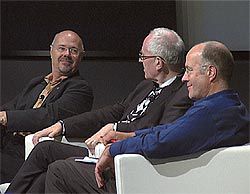
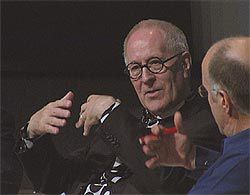
THIS IS A WORLD OF INSTANT BUILDINGS, MASTER PLANS TOMORROW AND A CITY BY FRIDAY. WHAT ARE THE POSSIBILITIES FOR ARCHITECTURE AND URBANISM UNDER THESE KINDS OF PRESSURES?
››
PETER COOK UK, IAN MCDOUGALL ARM, AUSTRALIA. FACILITATOR: CAREY LYON LYONS. GUESTS: ELI GIANNINI MCGAURAN GIANNINI SOON, HAMISH LYON NH ARCHITECTURE, YUNG HO CHANG ATELIER FEICHANG JIANZHU, CHINA.
››
CAREY LYON There are a couple of different issues in relation to time. One is the direct impact on practitioners working through the design process, and it sounds like in Ian’s experience it creates a condition of significant compromise. The second, which Peter commented on, was time as the condition of the city, the city being in a constant state of metamorphosis. I’m interested in comments on experiences of either of these conditions.
PETER COOK It’s weird, you know. I’ve been in Melbourne seven days and I’ve seen only two buildings, because the rest of the time one’s either in the loo, at the laptop, being nice to people, or buying shoes. It helps when you’re older. You haven’t got time to cover all the new things, but you have got, to use my analogy, a very big back pocket. There are lots of things in the pocket and you pull them out, when previously you would’ve been observing.
As a consultant, I’m also involved in schemes that go out by next Friday. But there are tremendous dangers in this because there isn’t time for the thing to evolve. There’s not even the time for the patina of ideas. On the other hand, the example I showed of the two Tel Aviv buildings with the little old shop underneath works because those buildings were based on 20 years of Modernist thinking. Then some Charlie opens up his little shop and the strength of the two buildings enables it to be any old thing. It can come and it can go. You have to balance between the solid and the serendipitous. In the days of megastructure one had this very simple theorem – the more developed the megastructure the looser the coming and going parts could be. If the megastructure was flimsy, with no rules, then the parts had to be rather determinate.
CL Ian, you used the word flawed a couple of times in terms of ARM’s participation in that ›› sort of process. Do you want to expand on that a little?
IAN MCDOUGALL I’d like to pick up on Peter’s thing about having stuff in your back pocket. It’s not so much reusing ideas as constantly exploring the same paradox or issues. The difficulty when things are done quickly is that there are resistant bits that refuse the strength of a new idea. So urban design in these conditions is about trying to get comfortable with the fact that you’re not envisaging a completed thing, you’re envisaging something that will grow and the bits that you put in facilitate accidents and growth. It’s wing and a prayer. You have to say, OK, I’m not designing the whole thing; I’m not even drawing the whole thing. It’s like a map that allows things to happen and you hope that the map has got all the right bits in it.
CL Yung Ho, how does that correspond with your experience?
YUNG HO CHANG I’d like to name a French philosopher, François Jullien. He wrote an article on Chinese time, where he argued that in the past the Chinese didn’t think about time. He raises a very interesting idea which is that the present is perpetuated, it’s constantly reinvented. There is no old and new. In the Western world, to make a big generalization, time goes on and on. In China time is more like a rubber band. You can stretch it a little. That’s what we’ve been doing.
CL But if you let go does it hurt?
YHC People do see it in a different kind of light. There is tremendous urgency – we want a building by tomorrow – but on the other hand, it’s okay if you are a day or two late.
ELI GIANNINI I wonder whether lack of time is funnelling what we do into a narrower and narrower and narrower spot. There is no time for research, there is no time for typological studies, and the idea of the developed master plan has gone. As architects we still try to find some order in what we do, but we are not able to consider what happens to the whole, or to the bits in between, because time is of the essence.
CL As a consequence you’re left with just what’s in your pocket, to use Peter’s metaphor.
PC Or observation. As a compensation you have to use all the hours of the day just watching things. There’s another pocket somewhere in the jacket, where you put the funny things. You see a dog crossing the street or a funny looking bus or somebody’s glasses, or red walls, and you say, I don’t know when I’m going to use that, but I’ll remember that one.
Good architecture, as I was brought up on it, had a certain consistency, a language – a certain door went with a certain window. Now that is also hit on the head. One can compensate, but you have to work very hard at being a collector and an observer. The reservoir has to be very rich in order for your immediate response to be more than “the now”. Of course, one usually sees the opposite. A lot of architects don’t look at anything except magazines to find the flavour of the month, but they don’t understand how it was arrived at. That’s a danger. You can also look at history, at certain European cities that were rebuilt after the Second World War, where things moved very quickly. It’s not that they wear badly, but they’re extremely boring. The slowly, slowly towns tend to be richer. The other tactic is to say even if the building is not good, the stuff that begins to patinize it might be interesting, but it’s a dodgy tactic.
CL Hamish, do you have observations regarding process and what it means in terms of changing the form of the city, in regard to the work you’ve been doing in Melbourne at QV?
HAMISH LYON The speakers brought the two points together well. Peter, as far as I can see, the “back pocket” is the capacity to use history on a daily basis as a vital ingredient in your work. Ian, when you were talking about your work from a professional level, there was an enormous empathy from the practising architects in the audience. These two things – the concept of history, the idea of linear time and the sheer bloody momentum of the market economy – make the instant city the most interesting subject facing architects today. They’ve now been flattened into a single event. The QV project is an example of a large (for Melbourne) urban-scale project where physical time was compressed in the construction time. Conceptual time was compressed, and also the programme. Residential, retail, commercial, bowling alleys, supermarkets – everything was squashed into one particular event. On that project, the final layer and I guess the final frontier for practising architects was that we had six, eight, ten architects all working on the project at the same time.
So it’s an issue that oscillates between the problem of history, the professional practice of architecture and – the most interesting part – the actual working method for architects. It’s the game I play with my children where you fold up the paper and someone draws the head and someone draws the body and someone draws the legs and you open it up and you all have a good laugh; to some extent that is how we are building our contemporary cities.
CL Yung Ho, you’re obviously in the hot seat in terms of the rapid urbanization in China. Can you reflect on the actual results of either the impact of time on process or the bigger idea of the new Asian city as this extraordinary, dynamic, always changing stuff. How do you judge it? How might it affect your practice or your teaching?
YHC Well, after today’s lecture I’m changing my mind at this very moment. Before these new pressures, I thought all students should learn to make good buildings, but now I wonder if it’s actually quite okay to do solid, second-rate buildings or to do kiosks. Either choice doesn’t seem too bad. A lot of students want to do first-rate buildings, yet they’ve never learnt how to put basic bricks and mortar together, so invariably they do third-rate buildings. That reality is rather scary. I don’t know how I’m going to go back to my school and talk to them more about these ideas … it’s like the B movies in the US, pretty entertaining in the end.
CL That’s right and the whole world is watching.
YHC In typical architecture schools we aspire to do masterpieces, but aren’t we really just trying to build a better daily life? I’d like to look into that kind of an argument more … Like I paid attention to all the vegetation in Peter’s drawing – they were delineated in great detail, the same as the building elements. I don’t think that was a decorative measure, rather it’s part of the environment. The idea of architects as creators of a new world probably should be questioned. Instead it is a matter of how we participate in the evolution of a world. In China very iconic buildings are being designed by important international architects, but I’m wondering if the icon, like five minutes of fame, will be substituted by something else.
CL You have touched on a number of key issues where the conventional architectural mind-set rubs up against the problem. These aren’t formal projects. As you said, they are projects about constantly remaking the present, ensuring that you don’t design out how real cities grow and work. The bits that aren’t designed are absolutely fundamental.
SPEAKER Peter, when you complete a work like the Graz Museum, do you see it as still an incomplete system? ›› PC What gives me great pleasure is the way that transvestite singers and so on use it in such unexpected ways. I wouldn’t mind if it was selling socks in five years’ time. Many buildings are used in ways they were not designed for, and some of them are very satisfactory “not designed”. To return to the notion of the second-rate building – the late Cedric Price used to accuse me of enjoying the second-rate. Speaking as a teacher, my great crie de coeuris that very few students enjoy looking at “stuff” – I’m a great believer in architectural trainspotting. If you fight your way through and end up with a second-rate building, one can actually have a much richer powerhouse to move forward, whereas if you just do something you think is the icon of the moment, what are you left with when the system moves on?
Strangely enough, the architect whose work I constantly like looking at is Asplund. The buildings are so full of ideas and the ideas don’t come just from Modernism or from stripped down Swedish classicists. Maybe he was a good observer too. On the other hand, one rather enjoys the come-day-go-day thing. It was easier to enjoy it about fifteen years ago when it was an exciting idea – that’s what Archigram came out of. Now it’s actually happening that fast, we’re saying, hey, hey, hold it Charlie … So, any of us working, we are automatically culturally and operationally split personality.
HL In the superscale project, the architect loses a great deal of control, you are subject to fast-flowing forces. That debate is particularly relevant here in Melbourne and in Australia, because the history of Australian architecture is rich. But there’s a debate now about how to deliver major projects – how to manage that process and still retain architecture. The international image of Australian architecture is dominated by the individual icon house. The superscale project is seen as commercially tainted or grubby, so it gets taken out of architectural discussion. Today’s speakers have highlighted how architecture can be part of everyday life in the urban environment, not just in the discrete individual object.
CL Ian, for a long time you have been an advocate of a strong local tradition. When you go and work internationally and you’re stuck for time, what do you fall back on? Is it your work in building a local tradition?
IM It’s a dilemma. You feel like the colonist, like the smart alec carpetbagger who comes in, has a go, then leaves. For the first international project that we worked on, some years ago now in Penang, we presented schemes that were a careful study of Malaysian design. They said, “I don’t think so.We want international.” It’s quite uncomfortable when you are asked to repeat what is supposedly done in Australia. I haven’t quite got used to that yet. I’m not sure how you overcome it. You start to say well, alright, what is the carpetbagger tradition? Having been very strong on understanding and reinterpreting our local architects, how do you then go and work somewhere which is culturally so different? I haven’t got an answer.We sort of try and use the material we have here and grow it in this exotic funny soil.
EG I don’t think we know how to be carpetbaggers. It’s interesting to look at a famous architect’s work in their own country and then to see their work elsewhere – it doesn’t have the same resonance. But then we have in our own backyard a building by a Danish architect that’s celebrated all over the world and is perfect. I don’t know if it’s serendipity.
IM Maybe we shouldn’t be so uncomfortable about it. I was in New Zealand recently and there was an exhibition of Ernst Plischke’s work – there’s an Austrian Modernist who went to New Zealand, did absolutely amazing work and that influenced the local tradition.
CL Yung Ho, how do you regard this issue of architects coming in and interpreting local traditions and exporting ideas from their local traditions into your culture?
YHC We are working in the context of a global economy, so we can’t actually say so-and-so is an Australian architect, meaning that he or she would be different from a New Zealand architect. I wouldn’t know the difference anyway. But I do think people have different cultural backgrounds from their education and so on and so forth. As an architect today everyone is quite a mixture of a lot of difference influences. What people really bring to a particular location has to do with a sensitive attitude and the right message to tackle a problem in a given frame of time, budget, site, climate and so on. If the person is not from there but he or she’s very sensitive and knows some tricks to get a few more days out of the client, that is probably better than the local person just trying to deliver the stuff overnight.
I have a friend, a Chinese architect. He’s very fast. He had a client came to his apartment, late in the evening, who wanted a master plan of a market right away.
CL Not the next morning?
YHC No, no. It’s like probably 8 pm. I need to have the design by 10 pm. So then the client sat in front of the TV and had some tea and my friend is drawing away. He wasn’t at all humorous about it. Two hours later the client went out the door with some drawings. Then my friend forgot about it. Maybe two weeks later, I don’t remember how long, he walked down the street and saw something familiar and of course it was the thing he draw that night.
CL The only city built off the back of a napkin. I’m sure there’s lots of empathetic practitioners out there with issues about time.
AUDIENCE (PETER SKINNER) If we go back twelve years, it was a leisurely time, but the money wasn’t there and architects were concerned about how fee-cutting would affect quality. Now, I think we’ve hit terminal velocity with this time-cutting. Peter Davidson said he did 75,000 dwellings in ten days – that’s twelve seconds per dwelling, or if he sleeps, eight seconds per dwelling. And these are dwellings for people to live their lives in.
IM In the scheme we showed, you couldn’t actually design the whole thing; you had to say, we’ll just get these three right, knowing they will repeat those. Peter’s probably in the same situation – a typological tower is repeated, so terminal velocity is probably not quite right.
EG I prefer the idea of resistance. It’s a kind of passive resistance, you just passively resist.
IM Is that when the phone stops ringing?
EG Yeah, probably, but I think he’s quite right about a terminal velocity.
HL It also raises the issue of what is meant by the word design. Ian showed that designing a master plan is now a different thing from what he was taught as a student in the 1970s. Even here in Melbourne major commercial apartment towers are being designed by architects where their involvement in the building is to get their name on the job. The idea of what designing means is transforming. For good and for bad.
IM Maybe I should also expand on the issue of attempting to postpone the end of your participation for as long as you can. So at the same time as you are presenting material, which is diagrams of ideas, you postpone the fulfilment of the contract so that you can actually think in greater depth as you’re going along. A crucial part of master planning is ensuring that the authorities are still interested in the project, while giving yourself enough time to do it.We haven’t quite worked out how to do that in China yet.
PC Listening to this conversation I want to get something off my chest. There’s a small town in the UK called Blandford where somebody did their Ionic columns upside down. Some provincial English had gone with their sketchbooks to Rome, but forgot which way up. If you can do that, you can do anything. This carpetbagger thing has happened across Europe. You can trace the spread of Art Nouveau up the North Sea – it’s all carpetbagging. In the centre of Oslo is a building by a student of Schinkel. He went down to Berlin, got Mr Schinkel to say yes, it was alright, went back, then got it slightly wrong. Architecture is full of this. Sometimes the third-rate is far more interesting than the first-rate.
AUDIENCE (WARREN KERR) Given that one of the roles of an architect is to advise clients, and I think this is something we don’t do as well as we should, I’m interested in the panel’s view on time advocacy. What role should we take in saying what is achievable and what is not possible? Should time advocacy be one of the skills of an architect?
HL It’s a difficult question. The idea of linear time is no longer something that a client or the marketplace accepts. In my father’s generation, the client would come knowing what they wanted. The experience now is that often a client says “I don’t even know what I want”. The architect’s role is increasing and it’s impossible to map out that sequence. Time is no longer such a significant component, it’s more the process of how you manage the expectation of what conceptual time means versus what contractual time means.
AUDIENCE Doing things in a highly compressed time frame can be a good thing. Perhaps one has a career that goes through phases of contemplation and phases of compression – those intense phases can actually be highly stimulating. My other thought is can we design things so that even if they’re not perfect now, they’re redeemable in the future?
IM The phase of contemplation is a good way to put it – you’re not involved in projects; you’re involved in various stages of thinking about things and observing things and gathering them together for later use. I think that is right. But we do need to do a lot more research and document that research. It is good to hothouse things quickly, but it shouldn’t end and that is the problem. And the second part of the question – Peter’s talk was all about the city constantly redeeming itself. Maybe we should be a little more hopeful.
YHC I wonder if a good design is an open invitation to a further intervention.
culture
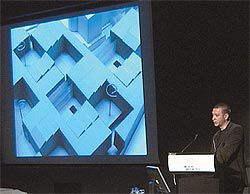
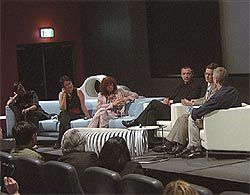
HOW IS A VIBRANT ARCHITECTURAL CULTURE PRODUCED? IS IT A PRODUCT OF EDUCATION, REGULATION, MEDIA OR SERENDIPITY?
››
HRVOJE NJIRIC NJIRIC+ARHITEKTI, CROATIA TIMOTHY HILL DONOVAN HILL, AUSTRALIA FACILITATOR LEON VAN SCHAIK RMIT GUESTS SHELLEY PENN, KRISTIN FEIREISS AEDES GALLERY, BERLIN, JUSTINE CLARK ARCHITECTURE AUSTRALIA ›› ››
LEON VAN SCHAIK I’m going to invite the guests to comment on the question.
KRISTIN FEIREISS What makes architecture successful? One thing that is absolutely necessary is communication – Timothy mentioned it when he said three quarters of an architect’s job is convincing clients. It begins at the university. In my experience, students of architecture are not trained to communicate. Everybody thinks communication is a personal talent, but it’s not, it’s part of the profession of an architect. Universities are also sometimes very isolated. They do wonderful research, but they often forget to communicate it.
Then there is communication on a national level. For example, in the Netherlands, architecture belongs to culture – it is seen as the cultural identity of the city. This is important. Dutch architects are well known internationally. This is not because they are more talented, but because they are more supported – you get support when you start your office, when you take part in an international competition, and research in the Netherlands is done in the offices. This is partly why different countries are seen differently concerning architecture.
I’ve been here for fourteen days and am very impressed. I’m wondering that what I have seen is not better known in the rest of the world because it’s incredible. So, what makes architecture successful? From my point of view, it’s communication.
SHELLEY PENN Cultures develop and die despite contrivance and despite self-consciousness. They have their own impetus. They’re not produced, but the aspects listed are important in fostering them. Vibrant architectural cultures come from practices pursuing idiosyncratic interests with passion, integrity and tenacity. Tim and Hrvoje both demonstrated those qualities, and Tim was quite eloquent about why tenacity is important – you have to battle and hold on tight to get something done. There also has to be some openness.We must respect integrity and passion wherever it exists.
For a number of years I worked in New South Wales with the government architect, Chris Johnson. Chris’s consultative role enables him to foster an architectural culture to some extent. He did this by contributing to the public awareness. This is important, but it is quite distinct from the internal culture of practice. There is a clear difference between that sort of public awareness and the internal architectural culture of a place. I’m interested in that difference.
JUSTINE CLARK On one hand it’s an unanswerable question. On the other, an answer is encapsulated in the very idea for this conference – exchange. Architectural culture is different from architecture as culture, or architecture and its relationship to high culture.We have a discipline that is centuries old, we have a culture as a profession and a discipline. To develop that we need to make and to think, but we also need to exchange ideas. Yes, we need to deal with it at the level of regulation, but also at the level of the discipline itself. For example, there is fine research in the universities, but most practitioners have no access to it; there’s also fine work going on in individual practices which many of us have little access to.
It’s only in having a really robust exchange among ourselves about the complexity of practice and of architecture as a discipline that we can then engage more fully with the world. Exchanges are one answer, so if there’s any time left we should have one!
LVS Well, maybe we could move into that mode. Hrvoje, I was struck by the way you use art to infect what you’re doing. Is that one of your major strategies in building a culture?
HRVOJE NJIRIC Well, it is certainly one of the strategies.We architects, as Peter Cook pointed out yesterday, have to fill our pockets with different phenomena or sensations. For us it’s a method of work which has been present for a long time. But I would like to pick up the argument about communication. The discussion we’ve had has remained very polite, but there are certain issues that I was really surprised by and that are interpreted in a completely different way in Europe. For example, diagrammatic expression has been mentioned in relation to very exact plans. In Europe we use the diagrams as a brief notation of architectural elements, with no ambition for spatial accuracy, in order to communicate ideas as efficiently as possible. I was also struck by the speakers who addressed “time” in terms of the time needed to produce the work. For me, the question is how is time contained in the architecture? What is the life span of the project? How do we build an ageing architecture? This idea of an open system, of process, is something that interests me, but I haven’t heard it discussed here. But maybe it’s not too late to also have some interventions from previous speakers.
Can we learn something from these cultural differences? I’m fascinated by the similarity with which Australian architects produce environments. How they relate to the landscape, how they assemble materials.We can reflect on this and pick up some examples for our own work.
SP Diversity is crucial. Yes, how wonderful to learn from other cultures, but, you know, I’d pray that we won’t all learn so much that we end up being the same.
LVS Timothy made a strong point about Ljubljana – where somebody with enormous ambition impacted on the city and eddies of ambition have carried on. That’s made the place more and more particular with a stronger and stronger local architectural culture.
TIMOTHY HILL I was drawing attention to that as a way of describing something. As a young practitioner still, youngish, I’m impatient with ideas of description and exchanges and all these things. They’re not actions. The thing with Ljubljana is that structural things were in place that let it occur. To be blunt, we need to adjust certain things in our cultural apparatus.We’re not just the products of bits of nuance and conversation. It’s political, it’s substructural. Joze Plecnik was the professor, the city architect, he had a very long tenure and he made a lot of difference. What if we transferred it to Australia? For example, imagine if the profession made a big effort to work out how design can be considered as a form of research for academic purposes, so that the activity that goes on in the practices could be academically assessed, so that people who are in practice could also have realistic and serious academic positions. If you change just one piece of structure, there would be a big change.
KF I have a comment concerning research. Architects with passion for the social also do their own research outside commissions. This is a very important aspect of the practice of architects.
TH It’s easy to agree with, but there’s no such thing as free research. Australian practices run on very low fees, set by senior members of the profession who don’t recognize that the fee guide is out of date and responds to “classical” conditions – briefs and sites and sign-offs – which don’t exist any longer.
SP But every era has its constraints. That’s where tenacity comes in.
TH No, it’s not, it’s the money.
SP I come back to passion, integrity … The other aspect of education and research is the first year – inspiring students to want to do it enough to go through all the shit that you have to go through to make architecture. They’re the ones that create the culture. Others foster it and nurture it, the government and the things we’ve all talked about. But that’s not creating culture.
TH All these people get nurtured, but then they hit the wall and realize they’re not earning any money, they have no scope to do research, because they’re flat out answering emails.
SP Yet we do have a rich architectural culture here.
TH No, we’re doing work vastly beneath our capacity.
SP I agree the fees are shocking and all that, but that is not where culture comes from.
TH Yes it is.
LVS I tend to agree with Timothy. Certain structural things that have to be in place.
KF But you cannot create a culture by giving money, there has to be a dialogue – when something special grows from within a culture, then it has to be supported.
LVS Thank you very much Kristin, Hrvoje, Tim, Shelley, Justine.We’ve opened up a huge debate.We’ve seen some terrific work and we’ve begun to have a conversation.

